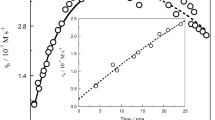Conclusions
-
1.
ESR signals for the dehydroascorbic acid radical-anions (D−) resulting from the interaction of AA with aqua ions and mono- and bis-α,α′-dipiridyl (dipy) complexes of Cu2+ have been recorded in a streaming system.
-
2.
An expression for the rate of generation of D− has been obtained, the mechanism of destruction of radicals had been established, and rate constants for the reaction of D− with Cu2, Cu2+dipy2, and Cu+ have been determined.
-
3.
Study has been made of the affect of acetonitrile on formation and destruction of radicals.
Similar content being viewed by others
Literature cited
E. V. Shtamm, A. P. Purmal', and Yu. I. Skurlatov, Zh. Fiz. Khim.,48, 2229 (1974).
E. V. Shtamm, A. P. Purmal', and Yu. I. Skurlatov, Zh. Fiz. Khim.,50, 1991 (1976).
V. F. Shuvalov, V. K. Fedorov, V. M. Berdnikov, and A. P. Moravskii, Kinet. Katal.,15, 898 (1974).
E.V. Shtamm, Dissertation, Moscow (1975).
N. V. Gorbunova, A. P. Purmal', and Yu. I. Skurlatov, Zh. Fiz. Khim.,49, 1995 (1975).
I. Yamazaki, H. S. Mason, and L. Piette, Biochem. Biophys. Res. Communs.,1, 336 (1959).
I. Yamazaki, H. S. Mason, and L. Piette, J. Biol. Chem.,235, 2444 (1960).
L. Piette, I. Yamazaki, and H. S. Mason, in: Free Radicals in Biological Systems [Russian translation], IL (1963), p. 237.
C. Lagercrantz, Acta Chem. Scand.,68, 562 (1964).
G. P. Laroff, R. W. Fessenden, and R. H. Schuler, J. Am. Chem. Soc.,94, 9062 (1972).
S. Steenken and G. Olbrich, Photochem. Photobiol.,18, 43 (1973).
R. D. McAlpine, M. Cocivera, and H. Chen, Can. J. Chem.,51, 1682 (1973).
Y. Kirino and T. Kwan, Chem. Pharm. Bull.,19, 718, 831 (1971).
E. V. Shtamm and Yu. I. Skurlatov, Zh. Fiz. Khim.,48, 1454 (1974).
B. H. Bielski, D. A. Comstock, and R. A. Boven, J. Am. Chem. Soc.,93, 5624 (1971).
M. Schöneshöfer, Z. Naturforsch.,27, 649 (1972).
E. V. Shtamm, A. P. Purmal', and Yu. I. Skurlatov, Zh. Fiz. Khim.,48, 2233 (1974).
B. R. James and R. J. P. Williams, J. Chem. Soc., 2007 (1961).
Yu. I. Skurlatov and A. P. Purmal', Zh. Fiz. Khim.,43, 1580 (1969).
Author information
Authors and Affiliations
Additional information
Translated from Izvestiya Akademii Nauk SSSR, Seriya Khimicheskaya, No. 1, pp. 61–66, January, 1977.
Rights and permissions
About this article
Cite this article
Moravskii, A.P., Skurlatov, Y.N., Shtamm, E.V. et al. Investigation of the mechanism of ascorbic acid radical formation and destruction. Russ Chem Bull 26, 49–54 (1977). https://doi.org/10.1007/BF00921491
Received:
Issue Date:
DOI: https://doi.org/10.1007/BF00921491



